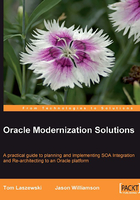
What This Book Covers
Chapter 1 gives an overview of the legacy modernization space. Here, we look at the different options for modernization and some of the drivers of modernization.
Chapter 2 Here, we will present an overview of modernization through SOA Integration. We will explore three strategies for SOA Enablement and when these options make sense.
Chapter 3 The focus of this chapter is to place SOA in the context of Modernization. SOA Legacy Modernizaton will bring you legacy IT infrastructure into the world of World Wide Web, Web 2.0, and all the other latest Internet-based IT architectures.
Within days, a legacy system can be accessed via a web browser. Your time-to-market using the Legacy SOA Integration approach is weeks, instead of months or years for some other modernization options.
Chapter 4 is an SOA Integration hands-on example using web enablement of mainframe COBOL/VSAM. We will use Java Server Pages (JSP), Java Database Connectivity (JDBC), the Oracle Legacy Adapter, Oracle Application Server, Java EE Connector API, and XA transaction processing to show a two-phase commit across an Oracle database and VSAM on the mainframe.
Chapter 5 takes a deep dive into what re-architecture is, how to approach re-architecture and strategies for execution. This will enable you to gain an understanding of this modernization option and prepare you for hands-on examples in the next chapters.
Chapter 6 Re-architecture is a multidimensional set of technologies and business drivers, similar to a Rubik's cube. In this chapter, we will simplify the target architecture variable, by making a move to Oracle. Even as we do this, we will find a wide selection of Oracle products and technologies, which we will narrow down for you. We end the chapter with a mapping of re-architecture business drivers to Oracle products, and finally a bit about modernization re-architecture and IBM.
Chapter 7 There are probably some legacy systems out there without batch, but it is most likely that batch processing is a key component of your mainframe legacy system. Business information processing in today's world is workload automation centered, event focused, and business-centric. However, we learn in this chapter that there are many reasons — both technical and business — why nightly batch jobs will be with us for some time. New technologies such as BPEL could potentially replace classic mainframe job scheduling software in the distant future.
Chapter 8 The online technical architecture has the potential to be much more complex than the batch open system architecture because the possible combination of products and technologies are endless. The combinations of target products and technologies include everything from cell phone access, to ERP application integration, to business intelligence, and transactions across multiple databases from different vendors. The same can be said of the source legacy system: multitudes of end user devices, languages, transactions processors, and databases. What we will immediately do is simplify the target architecture to three layers: presentation, transaction, business logic processing and database.
Chapter 9 The purpose of the scenario is to reinforce that re-architecture is not "rip and replace", but leveraging existing mainframe artifacts and forward engineering these artifacts into an Oracle/Java EE architecture using Relativity, and Oracle tools and products. The focus in this example will be on Relativity tools because the most complex and important aspects of re-architecture are discovery, recovery, capture of legacy artifacts, and creating a source model. The source application is a classic mainframe COBOL/CICS/VSAM/DB2 order entry system.
Chapter 10 Re-host based modernization approach is focused on migrating the application off the mainframe to a compatible software stack on an open-systems platform, preserving the language and middleware services on which the application has been built. It preserves legacy investment by relying on a mainframe-compatible software stack to minimize changes in the core application, and preserve the application's business logic intact, while running it on an open-system OS using more flexible and less expensive system infrastructure. It keeps open the customer's options for SOA enablement and re-architecture, by using an SOA-ready middleware stack to support Web services and ESB interfaces for re-hosted components.
Chapter 11 will let us examine trends in computing, where the modern data center is going and how this affects modernization choices today. We will see where the industry is trending with respect to tools, software and infrastructure. We'll examine concepts such as cloud computing, model driven modernization and green computing.
Appendix A gives an overview of the technological terms and legacy acronyms used throughout the book.